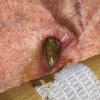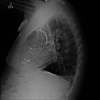Staphylococcus simulans bloodstream infection following CIED extraction
- PMID: 34045192
- PMCID: PMC8162074
- DOI: 10.1136/bcr-2020-240309
Staphylococcus simulans bloodstream infection following CIED extraction
Abstract
A 78-year-old man with an implantable cardioverter-defibrillator (ICD) presented with chills and malaise. His history was significant for heart failure with reduced ejection fraction and complete heart block. He had undergone permanent pacemaker placement that was later upgraded to an ICD 5 years before his presentation. Physical examination revealed an open wound with surrounding erythema overlying the device site. Blood cultures obtained on admission were negative. Transesophageal echocardiogram did not show valve or lead vegetations. He underwent a prolonged extraction procedure. Postoperatively, he developed septic shock and cultures from the device, and repeat peripheral blood cultures grew Staphylococcus simulans and Staphylococcus epidermidis He was treated with intravenous vancomycin but had refractory hypotension, leading to multiorgan failure. He later expired after being transitioned to comfort care. The patient may have acquired S. simulans by feeding cows on a nearby farm, and the prolonged extraction procedure may have precipitated the bacteraemia.
Keywords: infections; interventional cardiology; wound care.
© BMJ Publishing Group Limited 2021. No commercial re-use. See rights and permissions. Published by BMJ.
Conflict of interest statement
Competing interests: None declared.
Figures



Similar articles
-
Enterococcus durans Cardiac Implantable Electronic Device Lead Infection and Review of Enterococcus durans Endocarditis Cases.Medicina (Kaunas). 2022 Feb 17;58(2):307. doi: 10.3390/medicina58020307. Medicina (Kaunas). 2022. PMID: 35208630 Free PMC article.
-
Percutaneous pacemaker and implantable cardioverter-defibrillator lead extraction in 100 patients with intracardiac vegetations defined by transesophageal echocardiogram.J Am Coll Cardiol. 2010 Mar 2;55(9):886-94. doi: 10.1016/j.jacc.2009.11.034. J Am Coll Cardiol. 2010. PMID: 20185039
-
Echocardiography in detecting implantable cardioverter defibrillator lead endocarditis: case report.Acta Clin Croat. 2011 Mar;50(1):121-4. Acta Clin Croat. 2011. PMID: 22034793
-
Management of bacteremia in patients living with cardiovascular implantable electronic devices.Heart Rhythm. 2016 Nov;13(11):2247-2252. doi: 10.1016/j.hrthm.2016.08.029. Epub 2016 Aug 19. Heart Rhythm. 2016. PMID: 27546815 Review.
-
Device infections in implantable cardioverter defibrillators versus permanent pacemakers: A systematic review and meta-analysis.J Cardiovasc Electrophysiol. 2019 Jul;30(7):1053-1065. doi: 10.1111/jce.13932. Epub 2019 Apr 17. J Cardiovasc Electrophysiol. 2019. PMID: 30938929
Cited by
-
Farming Practice Influences Antimicrobial Resistance Burden of Non-Aureus Staphylococci in Pig Husbandries.Microorganisms. 2022 Dec 22;11(1):31. doi: 10.3390/microorganisms11010031. Microorganisms. 2022. PMID: 36677324 Free PMC article.
-
Staphylococcus simulans infections in a patient following high supracondylar osteotomy to treat osteoarthritis: a case report.J Surg Case Rep. 2024 Sep 6;2024(9):rjae567. doi: 10.1093/jscr/rjae567. eCollection 2024 Sep. J Surg Case Rep. 2024. PMID: 39246529 Free PMC article.
References
Publication types
MeSH terms
Supplementary concepts
LinkOut - more resources
Full Text Sources
Other Literature Sources
Medical
